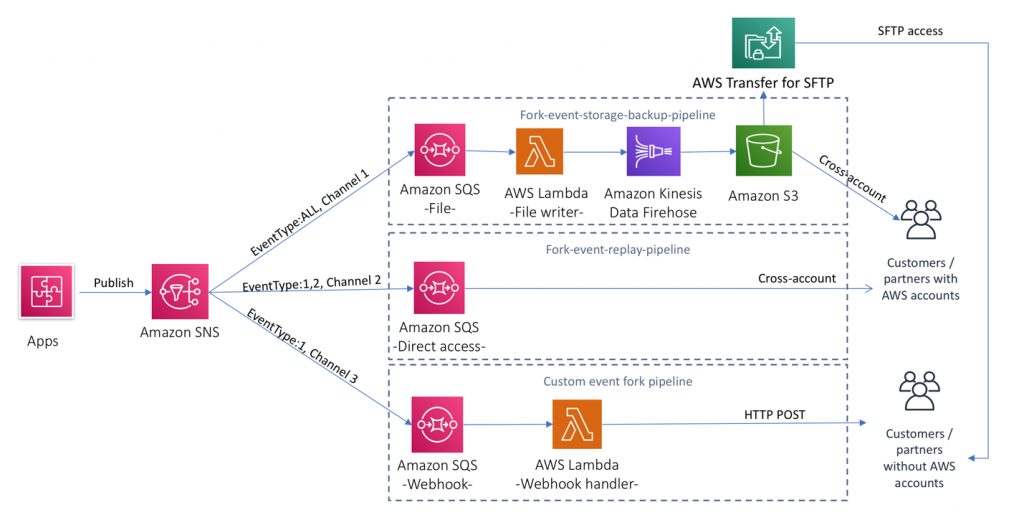AWS Compute Blog
Integrating B2B using event notifications with Amazon SNS
This post is courtesy of Murat Balkan, AWS Solutions Architect Event notification patterns are popular among B2B integrations. Their scalable and decoupled structure helps implement complex integration scenarios in a variety of enterprises. This post introduces a generic serverless architecture that applies to external integrations that use event notifications with Amazon SNS and Event Fork Pipelines. […]
Running ANSYS Fluent on Amazon EC2 C5n with Elastic Fabric Adapter (EFA)
Written by: Nicola Venuti, HPC Specialist Solutions Architect In July 2019 I published: “Best Practices for Running Ansys Fluent Using AWS ParallelCluster.” The first post demonstrated how to launch ANSYS Fluent on AWS using AWS ParallelCluster. In this blog, I discuss a new AWS service: the Elastic Fabric Adapter (EFA). I also walk you through an example that […]
Orchestrating an application process with AWS Batch using AWS CloudFormation
This post is written by Sivasubramanian Ramani In many real work applications, you can use custom Docker images with AWS Batch and AWS CloudFormation to execute complex jobs efficiently. This post provides a file processing implementation using Docker images and Amazon S3, AWS Lambda, Amazon DynamoDB, and AWS Batch. In this scenario, the user […]
Coming soon: Updated Lambda states lifecycle for VPC networking
On November 27, we announced that AWS Lambda now includes additional attributes in the function information returned by several Lambda API actions to better communicate the current “state” of your function, when they are being created or updated. In our post “Tracking the state of AWS Lambda functions”, we covered the various states your Lambda […]
New Express Workflows for AWS Step Functions
Today, AWS is introducing Express Workflows for AWS Step Functions. This is a new workflow type to orchestrate AWS services at a higher-throughput than existing workflows. Developers have been using AWS Step Functions since December 2016 to assemble long running workflows to orchestrate AWS Lambda Functions and other serverless services. Customers were looking for better […]
Announcing HTTP APIs for Amazon API Gateway
Amazon API Gateway helps developers easily create, publish, and maintain secure APIs at any scale. API Gateway handles all of the heavy lifting of managing thousands of API calls. There are no minimum fees and you only pay for the API calls you receive. Announcing the API Gateway HTTP API We talk to customers every day that […]
New for AWS Lambda – Predictable start-up times with Provisioned Concurrency
Since the launch of AWS Lambda five years ago, thousands of customers such as iRobot, Fender, and Expedia have experienced the benefits of the serverless operational model. Being able to spend less time on managing scaling and availability, builders are increasingly using serverless for more sophisticated workloads with more exacting latency requirements. As customers have […]
Accelerate migration and modernization of Windows Server workloads with AWS MAP for Windows
By Fred Wurden, GM Enterprise and Benchmarking AWS has spent the last 11 years working with you to migrate and run your Windows workloads on AWS, and gained valuable experience along the way. We’ve taken this learning and evolved our products, services, and programs to make AWS the best place to run Windows workloads. We […]
Using Amazon RDS Proxy with AWS Lambda
Update – June 30, 2020: Amazon RDS Proxy support for MySQL and PostgreSQL is now generally available. Update – April 8, 2020: We have announced Postgres compatibility with the Amazon RDS Proxy. Version 10.11 and 11.5 are supported in the preview. The AWS Serverless platform allows you to build applications that automatically scale in response to demand. […]
Introducing Amazon EventBridge schema registry and discovery – In preview
Today, AWS announces the preview of Amazon EventBridge schema registry and discovery. These are new developer tool features, which allow you to automatically find events and their structure, or schema, and store them in a shared central location. This makes it faster and easier to build event-driven applications. You can access the registry and generate […]









